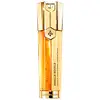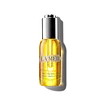What's inside
What's inside
 Key Ingredients
Key Ingredients

 Benefits
Benefits

 Concerns
Concerns

 Ingredients Side-by-side
Ingredients Side-by-side

Water
Skin ConditioningGlycerin
HumectantPropanediol
SolventAlcohol
AntimicrobialGluconolactone
Skin ConditioningButylene Glycol
HumectantPentylene Glycol
Skin ConditioningCaprylic/Capric Triglyceride
MaskingSqualane
EmollientMel
EmollientDiglycerin
HumectantMel Extract
MoisturisingRoyal Jelly
Sodium Hydroxide
BufferingPolyacrylate Crosspolymer-6
Emulsion StabilisingLauroyl Lysine
Skin ConditioningCoco-Caprylate/Caprate
EmollientGlyceryl Stearate
EmollientLimnanthes Alba Seed Oil
Skin ConditioningAvena Sativa Kernel Extract
AbrasiveParfum
MaskingGlycolic Acid
BufferingSorbitol
HumectantChlorphenesin
AntimicrobialCarbomer
Emulsion StabilisingCitric Acid
BufferingPPG-26-Buteth-26
Skin ConditioningLactic Acid
BufferingSodium Magnesium Silicate
Dimethicone
EmollientXanthan Gum
EmulsifyingSodium Hyaluronate
HumectantSodium Stearoyl Glutamate
CleansingPEG-40 Hydrogenated Castor Oil
EmulsifyingAlgin
MaskingSodium Benzoate
MaskingSodium Citrate
BufferingHydrolyzed Soy Flour
Skin ConditioningMalva Sylvestris Extract
AstringentAlbizia Julibrissin Bark Extract
MaskingTrisodium Ethylenediamine Disuccinate
Hydroxyacetophenone
AntioxidantAdenosine
Skin ConditioningRosmarinus Officinalis Leaf Extract
AntimicrobialPolyvinyl Alcohol
Biosaccharide Gum-2
Skin ConditioningCaprylyl Glycol
EmollientCaramel
Cosmetic ColorantCellulose Gum
Emulsion StabilisingPotassium Sorbate
PreservativeCI 77492
Cosmetic ColorantLactobacillus Ferment Lysate
Skin ConditioningYeast Ferment Extract
Skin ConditioningSilica
AbrasiveCI 77491
Cosmetic ColorantWater, Glycerin, Propanediol, Alcohol, Gluconolactone, Butylene Glycol, Pentylene Glycol, Caprylic/Capric Triglyceride, Squalane, Mel, Diglycerin, Mel Extract, Royal Jelly, Sodium Hydroxide, Polyacrylate Crosspolymer-6, Lauroyl Lysine, Coco-Caprylate/Caprate, Glyceryl Stearate, Limnanthes Alba Seed Oil, Avena Sativa Kernel Extract, Parfum, Glycolic Acid, Sorbitol, Chlorphenesin, Carbomer, Citric Acid, PPG-26-Buteth-26, Lactic Acid, Sodium Magnesium Silicate, Dimethicone, Xanthan Gum, Sodium Hyaluronate, Sodium Stearoyl Glutamate, PEG-40 Hydrogenated Castor Oil, Algin, Sodium Benzoate, Sodium Citrate, Hydrolyzed Soy Flour, Malva Sylvestris Extract, Albizia Julibrissin Bark Extract, Trisodium Ethylenediamine Disuccinate, Hydroxyacetophenone, Adenosine, Rosmarinus Officinalis Leaf Extract, Polyvinyl Alcohol, Biosaccharide Gum-2, Caprylyl Glycol, Caramel, Cellulose Gum, Potassium Sorbate, CI 77492, Lactobacillus Ferment Lysate, Yeast Ferment Extract, Silica, CI 77491
Limnanthes Alba Seed Oil
Skin ConditioningDimethicone
EmollientCaprylic/Capric Triglyceride
MaskingWater
Skin ConditioningTrisiloxane
Skin ConditioningPrunus Amygdalus Dulcis Oil
Skin ConditioningSimmondsia Chinensis Seed Oil
EmollientPolydecene
Skin ConditioningHydrogenated Polydecene
EmollientButylene Glycol
HumectantPropanediol
SolventGlycerin
HumectantAlgae Extract
EmollientBrassica Campestris Seed Oil
Skin ConditioningHelianthus Annuus Seed Oil
EmollientSesamum Indicum Seed Oil
EmollientEucalyptus Globulus Leaf Oil
PerfumingCamelina Sativa Seed Oil
Skin ConditioningOxycoccus Palustris Seed Oil
AntioxidantOlea Europaea Fruit Oil
MaskingHippophae Rhamnoides Oil
EmollientMedicago Sativa Seed Powder
Skin ConditioningHelianthus Annuus Seedcake
AbrasivePrunus Amygdalus Dulcis Seed Meal
AbrasiveSodium Gluconate
Skin ConditioningCopper Gluconate
Skin ConditioningCalcium Gluconate
HumectantMagnesium Gluconate
Skin ConditioningZinc Gluconate
Skin ConditioningTocopheryl Succinate
AntioxidantNiacin
SmoothingSesamum Indicum Seed Powder
Skin ConditioningLaminaria Ochroleuca Extract
Skin ConditioningLaminaria Saccharina Extract
Skin ProtectingHydrolyzed Algin
Sea Salt
AbrasiveChlorella Vulgaris Extract
Skin ConditioningSalicornia Herbacea Extract
Skin ConditioningSigesbeckia Orientalis Extract
Skin ConditioningLaminaria Digitata Extract
Skin ProtectingRosmarinus Officinalis Leaf Extract
AntimicrobialMagnolia Officinalis Bark Extract
AntimicrobialYeast Extract
Skin ConditioningCrithmum Maritimum Extract
Skin ConditioningCommiphora Mukul Resin Extract
Skin ConditioningCitrus Aurantifolia Peel Extract
CleansingMolasses Extract
Skin ConditioningSucrose
HumectantAcetyl Hexapeptide-8
HumectantAcetyl Glucosamine
Skin ConditioningCaffeine
Skin ConditioningTocopheryl Acetate
AntioxidantPhenyl Trimethicone
Skin ConditioningSodium Chloride
MaskingTetrahexyldecyl Ascorbate
AntioxidantAlcohol Denat.
AntimicrobialParfum
MaskingHexyl Cinnamal
PerfumingLinalool
PerfumingAmyl Cinnamal
PerfumingGeraniol
PerfumingLimonene
PerfumingCitral
PerfumingBenzyl Benzoate
AntimicrobialCoumarin
PerfumingCitronellol
PerfumingBHT
AntioxidantPhenoxyethanol
PreservativeCI 19140
Cosmetic ColorantCI 15985
Cosmetic ColorantLimnanthes Alba Seed Oil, Dimethicone, Caprylic/Capric Triglyceride, Water, Trisiloxane, Prunus Amygdalus Dulcis Oil, Simmondsia Chinensis Seed Oil, Polydecene, Hydrogenated Polydecene, Butylene Glycol, Propanediol, Glycerin, Algae Extract, Brassica Campestris Seed Oil, Helianthus Annuus Seed Oil, Sesamum Indicum Seed Oil, Eucalyptus Globulus Leaf Oil, Camelina Sativa Seed Oil, Oxycoccus Palustris Seed Oil, Olea Europaea Fruit Oil, Hippophae Rhamnoides Oil, Medicago Sativa Seed Powder, Helianthus Annuus Seedcake, Prunus Amygdalus Dulcis Seed Meal, Sodium Gluconate, Copper Gluconate, Calcium Gluconate, Magnesium Gluconate, Zinc Gluconate, Tocopheryl Succinate, Niacin, Sesamum Indicum Seed Powder, Laminaria Ochroleuca Extract, Laminaria Saccharina Extract, Hydrolyzed Algin, Sea Salt, Chlorella Vulgaris Extract, Salicornia Herbacea Extract, Sigesbeckia Orientalis Extract, Laminaria Digitata Extract, Rosmarinus Officinalis Leaf Extract, Magnolia Officinalis Bark Extract, Yeast Extract, Crithmum Maritimum Extract, Commiphora Mukul Resin Extract, Citrus Aurantifolia Peel Extract, Molasses Extract, Sucrose, Acetyl Hexapeptide-8, Acetyl Glucosamine, Caffeine, Tocopheryl Acetate, Phenyl Trimethicone, Sodium Chloride, Tetrahexyldecyl Ascorbate, Alcohol Denat., Parfum, Hexyl Cinnamal, Linalool, Amyl Cinnamal, Geraniol, Limonene, Citral, Benzyl Benzoate, Coumarin, Citronellol, BHT, Phenoxyethanol, CI 19140, CI 15985
Ingredients Explained
These ingredients are found in both products.
Ingredients higher up in an ingredient list are typically present in a larger amount.
Butylene Glycol (or BG) is used within cosmetic products for a few different reasons:
Overall, Butylene Glycol is a safe and well-rounded ingredient that works well with other ingredients.
Though this ingredient works well with most skin types, some people with sensitive skin may experience a reaction such as allergic rashes, closed comedones, or itchiness.
Learn more about Butylene GlycolThis ingredient is an emollient, solvent, and texture enhancer. It is considered a skin-softener by helping the skin prevent moisture loss.
It helps thicken a product's formula and makes it easier to spread by dissolving clumping compounds.
Caprylic Triglyceride is made by combining glycerin with coconut oil, forming a clear liquid.
While there is an assumption Caprylic Triglyceride can clog pores due to it being derived from coconut oil, there is no research supporting this.
Learn more about Caprylic/Capric TriglycerideDimethicone is a type of synthetic silicone created from natural materials such as quartz.
What it does:
Dimethicone comes in different viscosities:
Depending on the viscosity, dimethicone has different properties.
Ingredients lists don't always show which type is used, so we recommend reaching out to the brand if you have questions about the viscosity.
This ingredient is unlikely to cause irritation because it does not get absorbed into skin. However, people with silicone allergies should be careful about using this ingredient.
Note: Dimethicone may contribute to pilling. This is because it is not oil or water soluble, so pilling may occur when layered with products. When mixed with heavy oils in a formula, the outcome is also quite greasy.
Learn more about DimethiconeGlycerin is already naturally found in your skin. It helps moisturize and protect your skin.
A study from 2016 found glycerin to be more effective as a humectant than AHAs and hyaluronic acid.
As a humectant, it helps the skin stay hydrated by pulling moisture to your skin. The low molecular weight of glycerin allows it to pull moisture into the deeper layers of your skin.
Hydrated skin improves your skin barrier; Your skin barrier helps protect against irritants and bacteria.
Glycerin has also been found to have antimicrobial and antiviral properties. Due to these properties, glycerin is often used in wound and burn treatments.
In cosmetics, glycerin is usually derived from plants such as soybean or palm. However, it can also be sourced from animals, such as tallow or animal fat.
This ingredient is organic, colorless, odorless, and non-toxic.
Glycerin is the name for this ingredient in American English. British English uses Glycerol/Glycerine.
Learn more about GlycerinLimnanthes Alba Seed Oil is the oil extracted from the seeds of the meadowfoam plant. This oil is non-fragrant and is an emollient. As an emollient, meadowfoam seed oil helps soften and hydrate the skin.
Meadowfoam seed oil is stable and has a long shelf life due to its chemical structure. It has the highest concentration of stable fatty-acids among plant oils, preventing it from degrading once exposed to oxygen.
Due to the fatty acid content, this ingredient may not be fungal-acne safe.
Meadowfoam is native to California and Oregon.
Learn more about Limnanthes Alba Seed OilParfum is a catch-all term for an ingredient or more that is used to give a scent to products.
Also called "fragrance", this ingredient can be a blend of hundreds of chemicals or plant oils. This means every product with "fragrance" or "parfum" in the ingredients list is a different mixture.
For instance, Habanolide is a proprietary trade name for a specific aroma chemical. When used as a fragrance ingredient in cosmetics, most aroma chemicals fall under the broad labeling category of “FRAGRANCE” or “PARFUM” according to EU and US regulations.
The term 'parfum' or 'fragrance' is not regulated in many countries. In many cases, it is up to the brand to define this term.
For instance, many brands choose to label themselves as "fragrance-free" because they are not using synthetic fragrances. However, their products may still contain ingredients such as essential oils that are considered a fragrance by INCI standards.
One example is Calendula flower extract. Calendula is an essential oil that still imparts a scent or 'fragrance'.
Depending on the blend, the ingredients in the mixture can cause allergies and sensitivities on the skin. Some ingredients that are known EU allergens include linalool and citronellol.
Parfum can also be used to mask or cover an unpleasant scent.
The bottom line is: not all fragrances/parfum/ingredients are created equally. If you are worried about fragrances, we recommend taking a closer look at an ingredient. And of course, we always recommend speaking with a professional.
Learn more about ParfumPropanediol is an all-star ingredient. It softens, hydrates, and smooths the skin.
It’s often used to:
Propanediol is not likely to cause sensitivity and considered safe to use. It is derived from corn or petroleum with a clear color and no scent.
Learn more about PropanediolRosmarinus Officinalis Leaf Extract comes from rosemary. Rosemary is native to the Mediterranean.
While Rosmarinus Officinalis Leaf Oil can be volatile due to its fragrant properties, the fragrance components are usually removed in the leaf extract.
Rosemary Leaf Extract contains many antioxidants such as rosmarinic acid and caffeic acid. Rosemarinic acid, a compound found in rosemary leaf, has been found to help soothe skin conditions such as eczema and acne.
Learn more about Rosmarinus Officinalis Leaf ExtractWater. It's the most common cosmetic ingredient of all. You'll usually see it at the top of ingredient lists, meaning that it makes up the largest part of the product.
So why is it so popular? Water most often acts as a solvent - this means that it helps dissolve other ingredients into the formulation.
You'll also recognize water as that liquid we all need to stay alive. If you see this, drink a glass of water. Stay hydrated!
Learn more about Water